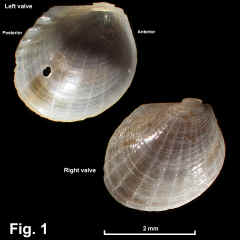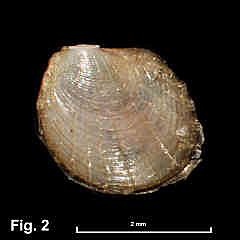|
|
PHILOBRYIDAE |
|
|
|
Cosa tatei (Hedley, 1901) Description: Shell minute. Prodissoconch a semicircular disc. Shape: subovate, extended posteriorly. Anterior and posterior ends smoothly rounded. Umbones at anterior quarter of hinge. Hinge line straight, with microscopic teeth, about 30 posteriorly, 15 anteriorly, separated by ligament pit. Interior white; margin with about 4 strong teeth posteriorly. Exterior with about 17 crisp, thin, widely spaced radial ribs, and concentric sculpture which varies from fine threads to dense, strong growth lines. Periostracum thin, fawn, extending beyond margin (Fig. 2). Shell colour white or fawn. Size: Up to 2.6 mm in length. Distribution: Off Facing Island (near Gladstone) Qld, southwards to Vic. and Tas. Habitat: Beach washup and down to 150 m. Common. Comparison: In shape and position of the umbones this species is similar to C. pharetra, but it differs by having sparse, crisp radial ribs. Synonymy: Cosa auriculata Laseron, 1953 (Fig. 3) is this species (NEW SYNONYM). The shell form, with the prodissoconch at the anterior quarter of the hinge, sculpture of sparse radial ribs, and dense periostracum is typical of C. tatei. Remarks: The original description and accompanying illustration of Cosa auriculata shows denticles all around the shell margin internally, which Hedley described as “alternate pits and bosses”. This character is not seen on any of the other 48 lots of this species in the Australian Museum collection; therefore, it seems that the syntypes are atypical (perhaps very mature) specimens. Fig. 1: Off Sydney, in 150 m depth (C.364691) Fig. 2: Laurieton, NSW, in 73m depth (C.364687) Fig. 3: Off Crookhaven NSW, in 55-64 m (30-35 fathoms) (C.186265) |
|


